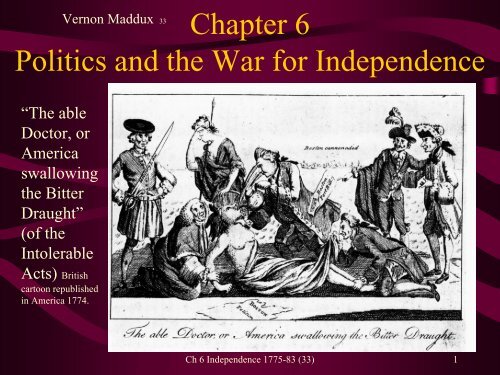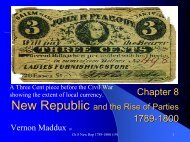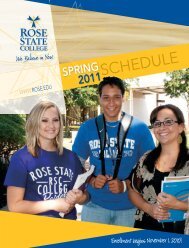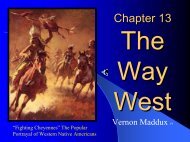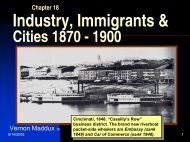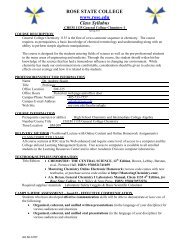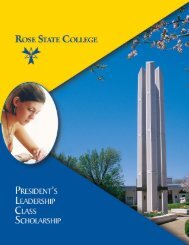Chapter 6: The War for Independence 1774-89 - Rose State College
Chapter 6: The War for Independence 1774-89 - Rose State College
Chapter 6: The War for Independence 1774-89 - Rose State College
Create successful ePaper yourself
Turn your PDF publications into a flip-book with our unique Google optimized e-Paper software.
Vernon Maddux 33<br />
<strong>Chapter</strong> 6<br />
Politics and the <strong>War</strong> <strong>for</strong> <strong>Independence</strong><br />
“<strong>The</strong> able<br />
Doctor, or<br />
America<br />
swallowing<br />
the Bitter<br />
Draught”<br />
(of the<br />
Intolerable<br />
Acts) British<br />
cartoon republished<br />
in America <strong>1774</strong>.<br />
Ch 6 <strong>Independence</strong> 1775-83 (33) 1
<strong>The</strong> British Army in North America<br />
Maj.Gen. Thomas Gage<br />
1721-1787<br />
A Lieutenant with Braddock,<br />
he became the Commanderin-Chief<br />
British Army in<br />
North America<br />
No British Army regiment had been<br />
permanently stationed in North America<br />
until 1770. By 1775 the American British<br />
army consisted of over 8,000 men , eight<br />
regiments in Boston, two in New York City.<br />
King George III had trouble recruiting troops<br />
in England <strong>for</strong> duty in America. He turned<br />
to his grandfather’s countrymen <strong>for</strong> help–<br />
from his grandfather’s province of Hesse he<br />
hired the Hessians.<br />
After the fighting in Lexington-Concord,<br />
British units from England and Canada<br />
are sent to occupy every New England<br />
colony, raising the total to 10,500.<br />
Free, a Revolutionary <strong>War</strong> song. Dr. Joseph <strong>War</strong>ren<br />
Ch 6 <strong>Independence</strong> 1775-83 (33) 2
First Blood- April 19, 1775<br />
Lexington & Concord “Two if by Sea” Two lanterns in the<br />
belfry of the Old North Church warn local settlements the British are moving across the bay in boats.<br />
<strong>The</strong> first shots of the <strong>War</strong> were<br />
fired at Lexington, an hour later<br />
more fighting at Concord<br />
• April 18. Gen. Gage ordered the capture<br />
of several agitators and removal of gun<br />
powder from all local militia armories.<br />
– Be<strong>for</strong>e dawn, Lt.Col. Francis Smith’s<br />
10 th Regiment of about 600 men<br />
stealthily crossed Charles Bay by boat.<br />
• Anticipating Gage’s move, William<br />
Dawes and Paul Revere were signaled to<br />
ride ahead and warn Samuel Adams and<br />
John Hancock and the Patriot <strong>for</strong>ces.<br />
– <strong>The</strong> local Patriots responded by<br />
assembling and confronting the British.<br />
• Shots were fired, Patriots were killed,<br />
but on the British retreat, 293 Redcoats<br />
were killed or wounded. Gage was<br />
astonished at his losses.<br />
Ch 6 <strong>Independence</strong> 1775-83 (33) 3
<strong>The</strong> Capture of Fort Ticonderoga<br />
May 10, 1775<br />
• Ethan Allen was leader of<br />
the quasi-illegal “Green<br />
Mountain Boys” of<br />
Vermont Territory.<br />
• Accompanied by Arron<br />
Burr, Allen surprised the<br />
British commander who<br />
had not heard of the<br />
fighting at Lexington and<br />
Concord.<br />
Be<strong>for</strong>e dawn, Ethan Allen wakes up<br />
and captures the British Garrison.<br />
• Allen seized 100 big cannon<br />
and by November he had<br />
hauled the guns overland to<br />
the heights above Boston.<br />
Ch 6 <strong>Independence</strong> 1775-83 (33) 4
Modern view looking northeast from<br />
Boston to Breed’s and Bunker Hill<br />
<strong>The</strong> 52 nd and 47 th regiments came<br />
under heavy fire from the dug-in<br />
Patriots. <strong>The</strong> British lost 50% of<br />
its <strong>for</strong>ce: 229 killed, 828 wounded.<br />
Battle of Bunker<br />
Hill June 17, 1775<br />
• Gage sent 5 regiments and all his<br />
Marines, over 5,000 men, against<br />
Bunker Hill. <strong>The</strong> soldiers first<br />
attacked up the shorter Breed's<br />
Hill, where colonial soldiers were<br />
entrenched. Three charges failed.<br />
• <strong>The</strong> 4 th charge by the Marines<br />
captured the hill, helped greatly<br />
by the lack of rebel ammunition.<br />
• Peter Salem of African descent,<br />
shot and mortally wounded the<br />
British officer leading the last<br />
charge which allowed most of the<br />
Americans to escape.<br />
Ch 6 <strong>Independence</strong> 1775-83 (33) 5
Battle of Great Bridge<br />
“2 nd Battle of Bunker Hill” December 9, 1775<br />
Norfolk, Virginia<br />
• Supported by two cannon firing over their<br />
heads, Capt Charles Fordice and Lt Batut<br />
led 500 grenadiers of the 14 th British<br />
Regiment, 100 Loyalists and black recruits<br />
on a frontal assault on the small <strong>for</strong>t at the<br />
end of a causeway. Almost all were killed.<br />
• <strong>The</strong> Virginia defenders, one company led<br />
by Lieutenant John Marshall of Fauquier<br />
Co., suffered no casualties.<br />
• Jan 1, 1776. <strong>The</strong> Virginia militia captured<br />
Norfolk. British ships bombarded and<br />
destroyed the town on Gov Dunmore<br />
orders. Dunmore’s destruction marked<br />
the end of British Crown rule in Virginia.<br />
Ch 6 <strong>Independence</strong> 1775-83 (33) 6
Second Continental Congress<br />
Philadelphia, Pennsylvania<br />
George Washington as a<br />
British Major<br />
• May 10, 1775. In a meeting called to<br />
respond to the fighting at Lexington-<br />
Concord, George Washington was<br />
elected to represent the Virginia<br />
House of Burgesses.<br />
• May 18. <strong>The</strong> Congress learned of<br />
Fort Ticonderoga’s capture.<br />
• May 19. News arrives that British<br />
military rein<strong>for</strong>cements are on their<br />
way from Canada to North America.<br />
• Nominated by Sam Adams, George<br />
Washington is confirmed to be a<br />
Lt.General, the Commander in Chief<br />
of the Continental Army.<br />
Ch 6 <strong>Independence</strong> 1775-83 (33) 7
Washington as CIC<br />
Lt. Gen. George Washington<br />
Commander in Chief of the Continental Army<br />
• Washington’s initial<br />
Strategy:<br />
– Defend New England<br />
and New York City.<br />
– Attack the British at<br />
Boston with captured<br />
cannon.<br />
• Above all, He must<br />
insure the survival of<br />
the army.<br />
Ch 6 <strong>Independence</strong> 1775-83 (33) 8
Jan 10 1776. Thomas Paine, a recent English immigrant to<br />
Pennsylvania publishes Common Sense in Philadelphia.<br />
“If Britain is our mother<br />
country then she is guilty of<br />
killing her children … An<br />
island should never rule a<br />
continent … the distance at<br />
which the Almighty hath<br />
placed England and America,<br />
is a strong and natural proof<br />
that the authority of the one<br />
over the other was never the<br />
design of Heaven … Tis<br />
time to part.”<br />
• Fantastically popular,<br />
Common Sense is a spirited<br />
plea <strong>for</strong> the colonies to break<br />
free from Britain.<br />
• Common Sense heavily<br />
influenced popular opinion. It<br />
convinced Congress to break<br />
with England and write the<br />
Declaration of <strong>Independence</strong>.<br />
Ch 6 <strong>Independence</strong> 1775-83 (33) 9
March 17 1776 Washington drives out Gen. Howe<br />
Bunker Hill<br />
cannons<br />
Boston<br />
• At night, Washington laid<br />
in Ticonderoga’s captured<br />
cannon on the hills above<br />
Boston harbor.<br />
• Howe immediately<br />
promises not to burn the<br />
town if he could evacuate<br />
all his men and ships.<br />
• Howe loads soldiers,<br />
horses, cattle and all<br />
Loyalists on his brother’s<br />
ships and leaves Boston.<br />
• It takes the British 17<br />
days to sail to Halifax,<br />
Nova Scotia.<br />
Ch 6 <strong>Independence</strong> 1775-83 (33) 10
Declaration of<br />
<strong>Independence</strong><br />
• Thrilled by the victory at<br />
Boston and impressed by<br />
the overwhelming<br />
response to Common<br />
Sense, in June, a special<br />
Congressional Committee<br />
produces a <strong>for</strong>mal<br />
statement of principles<br />
drafted by Thomas<br />
Jefferson.<br />
• <strong>The</strong> Declaration of<br />
<strong>Independence</strong> announces<br />
the creation of the United<br />
<strong>State</strong>s of America.<br />
Ch 6 <strong>Independence</strong> 1775-83 (33) 11
George Washington<br />
1731-1799<br />
Three Phases of the<br />
Revolutionary <strong>War</strong><br />
• 1775-77 Gentleman’s <strong>War</strong> in the<br />
North (Boston to the victory at Saratoga, NY)<br />
• 1776 –79 <strong>War</strong> of Attrition, Middle<br />
<strong>State</strong>s (NYC thru New Jersey back to NYC)<br />
• 1779-81 South, <strong>War</strong> Most Cruel<br />
and Savage (Invasion of Charleston, SC,<br />
Waxhaws; the final victory at Yorktown, Va)<br />
Ch 6 <strong>Independence</strong> 1775-83 (33) 12
Hudson<br />
River<br />
Manhattan<br />
Island<br />
Manhattan<br />
Long<br />
Island<br />
July 3 – Oct. 28 1776<br />
Battle of Long Island<br />
GW abandons New York City<br />
• July 3, 1776. <strong>The</strong> British Fleet<br />
arrives in NY harbor.<br />
• Aug. 22. 30,000 British and German<br />
troops land on Long Island losing<br />
400 men and 21 officers while killing<br />
3,000 Americans and capturing 2,000<br />
prisoners. Washington retreats to<br />
Manhattan Is.<br />
• Sept 15 Howe assaults Manhattan<br />
under a naval bombardment<br />
capturing 300 American soldiers and<br />
67 guns. Washington withdraws<br />
north to Harlem Heights. (Hibbert,<br />
126-27).<br />
• Oct. NYC Lost. Washington’s<br />
troops are driven out of the city and<br />
<strong>for</strong>ced to retreat north up the<br />
Hudson River.<br />
Ch 6 <strong>Independence</strong> 1775-83 (33) 13
Washington’s Headlong Retreat<br />
Southwest across New Jersey<br />
December 1776<br />
In devastating retreat, Washington’s 8,000 man Continental<br />
Army dwindles to a mere 3,000 starving men south of the<br />
Delaware River (Hibbert, 130-31). Behind them, British and German<br />
soldiers sweep through New Jersey, looting and pillaging (WS, 230).<br />
Ch 6 <strong>Independence</strong> 1775-83 (33) 14
Thomas Paine pens“<strong>The</strong> Crisis” during the retreat<br />
out of New York<br />
THESE ARE THE TIMES THAT<br />
TRY MEN'S SOULS. <strong>The</strong> summer<br />
soldier and the sunshine patriot<br />
will, in this crisis, shrink from the<br />
service of their country; but he that<br />
stands it now, deserves the love and<br />
thanks of man and woman.<br />
TYRANNY, LIKE HELL, IS NOT<br />
EASILY CONQUERED; yet we<br />
have this consolation with us, that<br />
the harder the conflict, the more<br />
glorious the triumph. What we<br />
obtain too cheap, we esteem too<br />
lightly: it is dearness only that gives<br />
every thing its value.<br />
<strong>The</strong> army’s ordeal<br />
inspires Thomas<br />
Paine to write this<br />
second powerful st of<br />
ideas toward<br />
patriotism.<br />
“<strong>The</strong> Crisis” first<br />
appears in the<br />
Pennsylvania Journal,<br />
on Dec 19 1776.<br />
Ch 6 <strong>Independence</strong> 1775-83 (33) 15
Pox Americana by Elizabeth A. Fenn<br />
18 th Century Germ <strong>War</strong>fare<br />
• Washington fears that Gen. Gage<br />
will spread small pox through his<br />
men from New York City.<br />
• All British soldiers are inoculated<br />
against the disease, but 80% of<br />
American soldiers were at risk.<br />
• 1777. In anguish, Washington,,<br />
ordered all his soldiers inoculated.<br />
• Hundreds die horribly, but the army<br />
survives.<br />
– About 8-10% of the American<br />
soldiers, perhaps 900 men catch the<br />
fatal disease and die.<br />
Ch 6 <strong>Independence</strong> 1775-83 (33) 16
Battle of Saratoga<br />
Oct. 17, 1777<br />
Benedict Arnold<br />
1741-1801<br />
• 1777 Summer. <strong>The</strong> British army in<br />
Canada, 8,000 men (half German)<br />
under Gen. John Burgoyne attacked<br />
south into New York.<br />
• <strong>The</strong> British army in New York City,<br />
6,000 men under William Howe are<br />
supposed to make a simultaneous<br />
attack up the Hudson to meet at<br />
Albany, New York.<br />
• Howe refuses to move north.<br />
• 1777, Oct. <strong>The</strong> American army under<br />
Horatio Gates and Benedict Arnold, aided<br />
by Col Daniel Morgan, defeat and capture<br />
Burgoyne’s entire Northern <strong>for</strong>ce.<br />
Ch 6 <strong>Independence</strong> 1775-83 (33) 17
<strong>War</strong> at Sea<br />
• Late in 1775, the Continental Congress<br />
establishes the navy: 13 vessels were to be<br />
built or purchased by 1776.<br />
• Congressman Robert Morris "Agent of<br />
Marine" is the eminent financier of the<br />
Revolution’s naval affairs from his<br />
committee.<br />
• Morris also sent out privateers on his own<br />
account, a business in which several other<br />
patriots participated.<br />
– General Washington funded six privateers.<br />
• 1778. After the victory at Saratoga, the U.S.<br />
Navy becomes the critical link to France,<br />
which joins the war against the British and<br />
sends millions of financial aid to America.<br />
Ch 6 <strong>Independence</strong> 1775-83 (33) 18
Articles of Confederation<br />
After Burgoyne’s defeat at Saratoga,<br />
the 2 nd Continental Congress felt<br />
secure enough to <strong>for</strong>malize the<br />
rules of government <strong>for</strong> the United<br />
<strong>State</strong>s.<br />
To establish the base <strong>for</strong> national law<br />
and government, Congress wrote<br />
down the methods it had used since<br />
1775.<br />
<strong>The</strong>se rules are known as the Articles<br />
of Confederation.<br />
<strong>The</strong> Articles<br />
Ch 6 <strong>Independence</strong> 1775-83 (33) 19
<strong>The</strong> Articles<br />
1778-81<br />
John Hancock<br />
1737-1793<br />
• <strong>The</strong> Articles of Confedertion<br />
establish a government that<br />
represents a loose league of<br />
individual nation-states, much like<br />
the Dutch Republic.<br />
• All legislation was by committee.<br />
• Taxation, control of trade and<br />
issuance of money are left to each<br />
sovereign state.<br />
• Each state had one vote in Congress.<br />
• Major decisions required the<br />
agreement of nine states.<br />
• To amend the Articles required<br />
unanimous consent.<br />
• It takes three years <strong>for</strong> all states to<br />
ratify the Articles in 1781.<br />
Ch 6 <strong>Independence</strong> 1775-83 (33) 20
French Support Feb 6 1778. Treaty of Alliance and<br />
Amity and Commerce is signed in Paris<br />
by Ben Franklin <strong>for</strong> the US signaling the<br />
first official recognition of the new<br />
American republic by a European power.<br />
• July 10 1778. King Louis XVI of France<br />
declares war on Great Britain making the<br />
American Revolutionary <strong>War</strong> also a war<br />
between the two great powers.<br />
• Americans remain too weak to dislodge the<br />
British from the port cities of Philadelphia<br />
and New York but they make occupation<br />
Lafayette<br />
Marie Joseph Paul Yves<br />
Roche Gilbert du Motier,<br />
the Marquis de Lafayette<br />
1727-1834<br />
very expensive <strong>for</strong> the British.<br />
• While the war destroyed the economy of the<br />
U.S., the treaty with King Louis’ provided<br />
enough military and economic assistance<br />
<strong>for</strong> the infant country to survive.<br />
Ch 6 <strong>Independence</strong> 1775-83 (33) 21
Admiral Richard<br />
“Black Dick” Howe<br />
MGen Henry Clinton<br />
1738-95<br />
Phase III<br />
<strong>The</strong> Invasion of the<br />
South 1779-81<br />
Gen Charles<br />
Cornwallis<br />
1738-1805<br />
Mgen William Howe<br />
1729-1814<br />
BGen Charles<br />
“No Flints” Grey<br />
1729-1807<br />
“<strong>The</strong> inhabitants of the province<br />
(South Carolina), who have<br />
taken part in this revolt,<br />
should be punished with the<br />
greatest rigour” 1779--<br />
Cornwallis<br />
Ch 6 <strong>Independence</strong> 1775-83 (33) 22
Banastre Tarleton<br />
1754-1833<br />
He published "History of the Campaigns of<br />
1780 and 1781 in the Southern Provinces of<br />
North America " (London, 1787).<br />
Banastre Tarleton<br />
BUTCHER OF WAXHAWS<br />
On 29 May 1780 Tarleton with 700 cavalry<br />
and mounted infantry, surprised and<br />
slaughtered about 400 of the 11 th Virginia<br />
commanded by Col Abraham Bu<strong>for</strong>d, the<br />
last "Continental" unit in South Carolina.<br />
Bu<strong>for</strong>d and about a 100 infantry, escaped<br />
while the rest were surrounded and asked<br />
<strong>for</strong> quarter. None was granted and 113<br />
Patriots were killed on the spot; 150 were<br />
later found too badly injured to be moved;<br />
53 survived to die at Camden.<br />
<strong>The</strong> report of the Waxhaws massacre near the<br />
NC/SC border excited horror and anger<br />
throughout the land.<br />
Tarleton received from Lord Cornwallis the<br />
highest praise <strong>for</strong> this action.<br />
Ch 6 <strong>Independence</strong> 1775-83 (33) 23
Battle of Cowpens<br />
Jan. 17, 1781<br />
Daniel Morgan destroys<br />
Tarleton’s British Legion of<br />
1,100 American Loyalists<br />
• BGen Daniel Morgan<br />
plotted revenge against<br />
Tarleton and obtained<br />
one of the Revolution’s<br />
greatest victories.<br />
• Morgan with 1,000 men,<br />
defeated Tarleton’s<br />
British Legion of 1,100<br />
Americans (mostly New<br />
York and New Jersey<br />
Loyalists)-at Hanna’s<br />
Cowpens, north of<br />
present Spartanburg,<br />
South Carolina.<br />
Ch 6 <strong>Independence</strong> 1775-83 (33) 24
Naval Battle of Chesapeake Bay<br />
Sept 5 1781<br />
Seven months after<br />
Cowpens<br />
• Sept 5 1781. French <strong>for</strong>ces defeated the British Royal Navy in the<br />
Chesapeake, cutting off Cornwallis's supplies and transport.<br />
• Oct 6 1781. An American-French <strong>for</strong>ce of 17,000 troops led by<br />
Washington surrounds and defeats Cornwallis at Yorktown, Va.<br />
Ch 6 <strong>Independence</strong> 1775-83 (33) 25
<strong>The</strong> British Surrender at Yorktown<br />
Oct. 19 1781<br />
Cornwallis Surrenders<br />
<strong>The</strong> combined infantry of generals Washington-Lafayette,<br />
Rochambeau’s French army and Adm. de Grasse’s great fleet<br />
converged on the last concentration of British troops which were<br />
backed up against the York River inside Chesapeake Bay.<br />
Cornwallis was <strong>for</strong>ced to surrender without Military Honors.<br />
Ch 6 <strong>Independence</strong> 1775-83 (33) 26
Women Patriots<br />
Gen. Washington salutes<br />
a soldier’s wife who is an<br />
acting artilleryman<br />
• Mercy <strong>War</strong>ren wrote anti-British<br />
plays and pamphlets; women<br />
organized boycotts against British<br />
goods.<br />
• Benjamin Franklin's daughter, Sarah<br />
Read Franklin Bache funded<br />
clothing drives <strong>for</strong> the troops.<br />
• When captured by the British, Emily<br />
Geiger of South Carolina, age 17,<br />
memorized then ate the message she<br />
was taking to Gen. Nathan Greene.<br />
Once freed, she rode 100 miles and<br />
delivered it from memory.<br />
• 20,000 wives of Continental soldiers<br />
marched from battle to battle with<br />
Washington’s troops, carrying their<br />
baggage and babies.<br />
Ch 6 <strong>Independence</strong> 1775-83 (33) 27
Molly Pitcher & Deborah Sampson<br />
Molly Pitcher helped fire her<br />
husband’s cannon at the battle<br />
of Monmouth in 1778.<br />
• Mary Hayes (Molly Pitcher) and<br />
Margaret Corbin, fired their<br />
husbands' artillery pieces after<br />
their husbands were wounded at Ft<br />
Washington, NY (1776); and at<br />
Monmouth, NJ (1778).<br />
• Deborah Sampson trained as a<br />
Connecticut schoolteacher but<br />
donned men's clothes and served<br />
in Washington's army as a soldier.<br />
– When wounded, her gender was<br />
discovered by a doctor and her unit<br />
discharged her.<br />
– Washington ordered that she<br />
receive a full pension.<br />
Ch 6 <strong>Independence</strong> 1775-83 (33) 28
African-Americans in the Revolution<br />
Crispus Attucks<br />
1723-1770<br />
Killed in the Boston<br />
Massacre<br />
• When the British promised freedom to slaves,<br />
2 nd Continental Congress responded by<br />
authorizing the enlisting of slaves-promising<br />
them freedom <strong>for</strong> honorable service.<br />
• Black soldiers from the north fought at every<br />
early battle: Lexington-Concord, Bunker Hill<br />
and in all major battle of the war. Many<br />
African Americans served in the US Navy.<br />
• One all-black Santo Domingo unit, under<br />
French command, fought at Savannah.<br />
• However, African-Americans were never<br />
recruited by Virginia, Georgia, or the<br />
Carolinas.<br />
• Twenty years after the war, the issue of slave<br />
and racial divide sharply split the new<br />
country. It was also a major controversy at<br />
the Constitutional Convention of 1787.<br />
Ch 6 <strong>Independence</strong> 1775-83 (33) 29
First Steps toward Emancipation<br />
• At least 100,000 slaves escaped to Canada<br />
or to the British. At least 27,000 who fled<br />
their plantations died of small pox.<br />
• Exploiting the rhetoric of the Revolution<br />
to petition <strong>for</strong> freedom and equality, US<br />
freedmen gained leverage in the North.<br />
• Everywhere, except in the South, strong<br />
emancipation movements developed.<br />
• Thomas Paine and Benjamin Franklin (d.<br />
1790), James Otis (1724-1783), Benjamin<br />
Rush (1745-1813) all supported abolition.<br />
• 1816. Robert Finley organized “Return<br />
to Africa” programs and created a new<br />
country called “Liberia.”<br />
• For the first few decades every state<br />
limited or abolished its slave trade.<br />
• Everywhere, even in the South, owners<br />
freed some slaves.<br />
Ch 6 <strong>Independence</strong> 1775-83 (33) 30
• Liberia-<strong>The</strong> American Colonization Society.<br />
• Dec 21 1819. Washington DC. With Finley, Henry Clay,<br />
James Monroe, Bushrod Washington, Andrew Jackson,<br />
Francis Scott Key & Daniel Webster relentlessly pressured<br />
Congress to increase the African Colonization project.<br />
• Jan 1820. With $100,000 from Congress, the first ship,<br />
Elizabeth sailed from New York with 3 white ACS agents<br />
and 88 black emigrants. Reaching the coast of Liberia, all<br />
whites and 22 of the Black emigrants died from yellow fever<br />
within three weeks. <strong>The</strong> survivors returned to Sierra Leone.<br />
• 1821. ACS Nautilus dropped immigrants on an island called<br />
Perseverance in Mesurado Bay. Native Africans resented and<br />
attacked the new settlers but by 1830, 2638 African-<br />
Americans had migrated to Liberia.<br />
• 1842. Joseph Jenkins Roberts became the first non-white<br />
governor. 1847. Roberts declared Liberia an independent state<br />
and was elected as first President.<br />
Ch 6 <strong>Independence</strong> 1775-83 (33) 31
Freedom Proclaimed <strong>for</strong><br />
All<br />
But Denied to Some<br />
Butler Island Slave<br />
Quarters, South Carolina<br />
• By 1783 six state constitutions<br />
(Vermont, Connecticut, Rhode<br />
Island, Pennsylvania, New York<br />
and New Jersey) had abolished<br />
slavery.<br />
• Legal emancipation was quickly<br />
achieved in New Hampshire<br />
and Massachusetts.<br />
• 1783. In Massachusetts African-<br />
Americans won the vote, a<br />
precedent slowly adopted by<br />
other Northern states.<br />
• Southern states discussed<br />
abolition but failed to pass<br />
legislation (in 1792 Virginia the<br />
abolition of slavery failed by one<br />
vote).<br />
Ch 6 <strong>Independence</strong> 1775-83 (33) 32
Treaty of Paris<br />
Sept. 3, 1783<br />
American American commissioners: commissioners: John John JAY, JAY, Ben Ben<br />
FRANKLIN, FRANKLIN, John John ADAMS. ADAMS. Front: Front: English English<br />
minister minister chief chief negotiator negotiator (<strong>for</strong> (<strong>for</strong> Earl Earl of of<br />
Shelburne Shelburne<br />
Secretary<br />
Secretary<br />
of<br />
of<br />
<strong>State</strong>)<br />
<strong>State</strong>)<br />
Richard Richard<br />
OSWALD; OSWALD; not not pictured, pictured, David David HARTLEY. HARTLEY.<br />
<strong>The</strong><br />
<strong>The</strong><br />
painting<br />
painting<br />
is<br />
is<br />
incomplete<br />
incomplete<br />
because<br />
because<br />
the<br />
the<br />
two<br />
two<br />
British<br />
British<br />
negotiators<br />
negotiators<br />
refused<br />
refused<br />
to<br />
to<br />
sit<br />
sit<br />
<strong>for</strong><br />
<strong>for</strong><br />
the<br />
the<br />
painter<br />
painter<br />
symbolizing<br />
symbolizing<br />
the<br />
the<br />
continuing<br />
continuing<br />
division<br />
division<br />
between<br />
between<br />
Great<br />
Great<br />
Britain<br />
Britain<br />
and<br />
and<br />
its<br />
its<br />
<strong>for</strong>mer<br />
<strong>for</strong>mer<br />
American<br />
American<br />
colonies-leading<br />
colonies-leading<br />
to<br />
to<br />
the<br />
the<br />
<strong>War</strong><br />
<strong>War</strong><br />
of<br />
of<br />
1812.<br />
1812.<br />
• Agreement: <strong>The</strong> independence<br />
of the United <strong>State</strong>s is granted.<br />
• United <strong>State</strong>s boundaries:<br />
Atlantic coast to Mississippi<br />
River; from 49 th parallel and<br />
Great Lakes south to the 31 st<br />
parallel (all land east of the<br />
Mississippi except Florida and<br />
the city of New Orleans)<br />
• American fishing rights is<br />
granted to New England on the<br />
Newfoundland banks.<br />
• (Specific British demand) Each<br />
state should return seized property<br />
to its Loyalist citizens.<br />
Ch 6 <strong>Independence</strong> 1775-83 (33) 33


